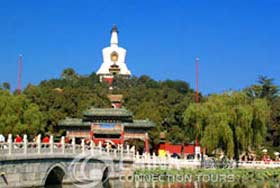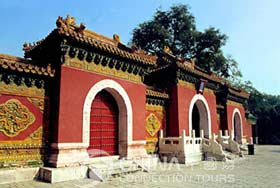
 Beihai (North Sea) Park is one of the most popular parks in the city of Beijing . It covers a total area of over 68 hectares, more than half of it is taken up by the lake. Located northwest of the Forbidden City, this park has an 800-year history as the royal garden -- and playground -- of the Jin, Yuan, Ming and Qing dynasties. It is used to be the former palace of the emperors in successive dynasties, called the Winter Palace by Westerners. Early in the 10th century, the Liao dynasty a secondary imperial palace and an island (Jade Islet) were built here. It was expanded by digging a lake, adding more palace halls when Jin Empire took over; during the Yuan dynasty was rebuilt three times. The Ming and the Qing saw more construction and renovation: The Five Dragon Pavilions and the Nine-dragon Screen and pavilions were added. A White Dagoba, an onion-shaped shrine pagoda in Tibetan style, was erected in honor of the fifth Dalai Lama's visit to Beijing in 1651.
Beihai (North Sea) Park is one of the most popular parks in the city of Beijing . It covers a total area of over 68 hectares, more than half of it is taken up by the lake. Located northwest of the Forbidden City, this park has an 800-year history as the royal garden -- and playground -- of the Jin, Yuan, Ming and Qing dynasties. It is used to be the former palace of the emperors in successive dynasties, called the Winter Palace by Westerners. Early in the 10th century, the Liao dynasty a secondary imperial palace and an island (Jade Islet) were built here. It was expanded by digging a lake, adding more palace halls when Jin Empire took over; during the Yuan dynasty was rebuilt three times. The Ming and the Qing saw more construction and renovation: The Five Dragon Pavilions and the Nine-dragon Screen and pavilions were added. A White Dagoba, an onion-shaped shrine pagoda in Tibetan style, was erected in honor of the fifth Dalai Lama's visit to Beijing in 1651.
The layout of the park is based on an ancient Chinese legend. According to the legend, there were supposed to be three islands to the east of Bohai Bay where the gods lived. One of them was called Penglai Island where a kind of herbal medicine grew, that was supposed to prolong  life. The first emperor of the Qin Dynasty wanted to live forever. He sent people to the islands to look for the longevity medicine, but failed. Emperor Wudi of the Han Dynasty also wanted to live an eternal life. He ordered that a big pool be dug at the back of his palace, complete with three artificial hills to represent Penglai and the other islands. So these legendary hills were built in the eastern capital of Luoyang during the Sui Dynasty and also in the Tang Dynasty capital of Chang'an. Such a traditional style of gardening was followed during the succeeding dynasties and Beihai Park was built after this traditional style.
life. The first emperor of the Qin Dynasty wanted to live forever. He sent people to the islands to look for the longevity medicine, but failed. Emperor Wudi of the Han Dynasty also wanted to live an eternal life. He ordered that a big pool be dug at the back of his palace, complete with three artificial hills to represent Penglai and the other islands. So these legendary hills were built in the eastern capital of Luoyang during the Sui Dynasty and also in the Tang Dynasty capital of Chang'an. Such a traditional style of gardening was followed during the succeeding dynasties and Beihai Park was built after this traditional style.
Now it is a popular park, half of which is a lake. It boasts one of the best of China's classical gardens with artificial hills, pavilions, halls, temples and covered corridors. Besides the lake, the main things to see are the Round City, which contains a jade vase from the time of Kublai Khan; the Temple of Eternal Peace; the Nine Dragon Screen, which is actually a 5-metre-high, 27-metre-long wall covered with glazed tiles carved into nine intertwining dragons; and the White Dagoba on Jade Isle in the center of the lake, visitors can have an excellent view of the Five Dragon Pavilions standing on the opposite bank of the lake, with colorful ferry boats traveling back and forth between the shores.
In summer, Beihai is an ideal place to escape from heat.

